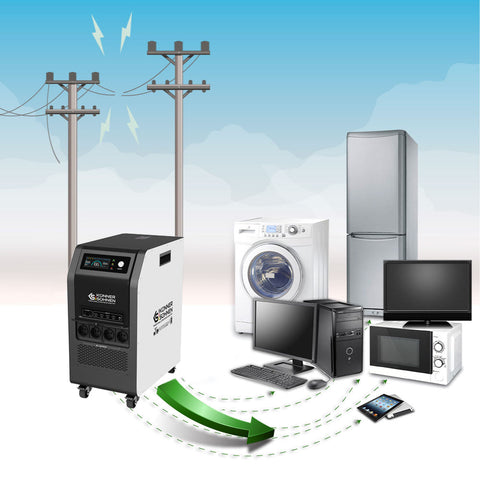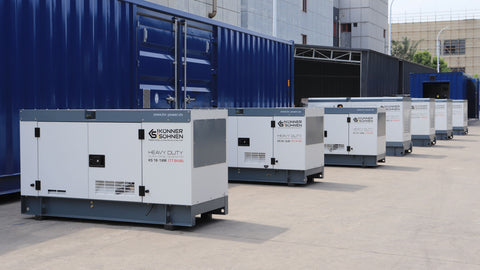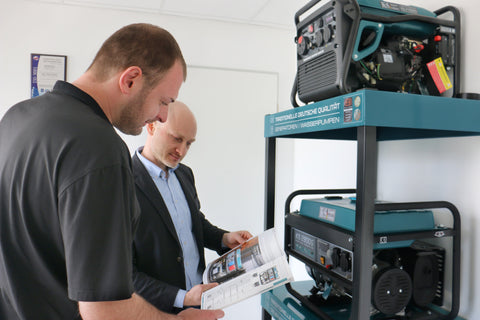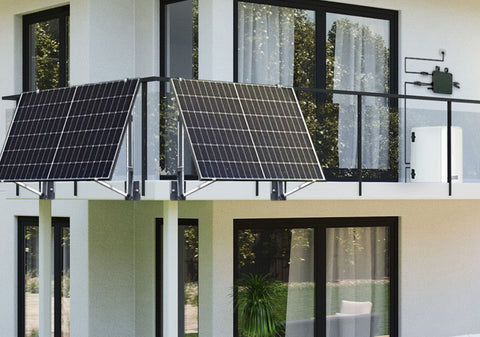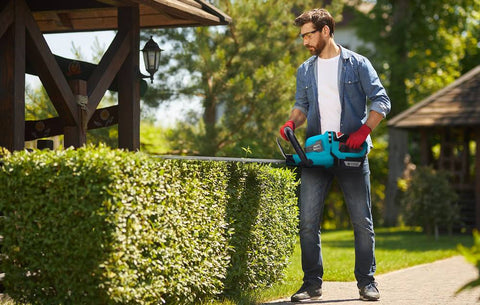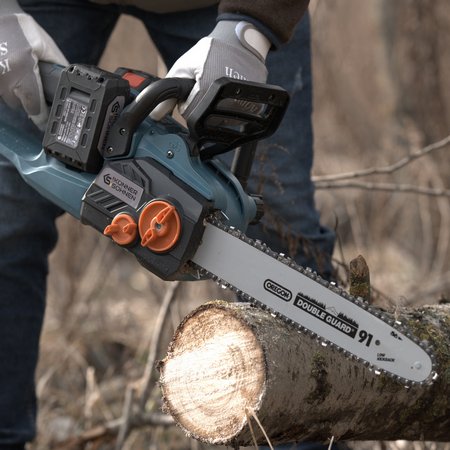The question always arises: which generator is right for the intended use?
What voltage and how much power do my electrical devices actually need?
Difference between the public power grid and an emergency generator
An emergency power generator cannot be equated with the public power grid, as an emergency power supply is always a stand-alone power solution. The emergency power generator, together with the connected power consumers, forms a closed system whose elements interact with one another.
In the public power grid, the loads are distributed so that all three phases are loaded approximately symmetrically and the remaining unbalanced load (uneven loading of the phases) and the associated zero point shift is compensated for by compensating windings, zigzag circuits, etc. in the transformers used.
In a house with a 3-phase external power supply, the loads are predominantly 230V power consumers and asymmetrical loading is therefore inevitable and can be extreme under certain conditions.
This can cause problems with a three-phase emergency power supply. This shouldn't be a problem with low power consumption (usually up to 10-20% of the rated power per phase), but not if you're using a kettle or a hob on an electric stove, for example.
Example:
The house is supplied with power from a non-unbalanced load emergency generator via a 400V outlet. As long as all three phases are equally loaded or only a few hundred watts, the voltage remains within the permissible tolerance range of 230V +/- 10% per phase. However, if a kettle or a cooktop on an electric stove is used, the voltages on the three phases diverge and fall outside the permissible 230V +/- 10% range. This can cause overvoltage damage to the connected electrical devices.
The lower the rated power of the emergency generator, the more significant the difference is for the same load. Therefore, the effect is more pronounced for smaller 3-phase generators than for larger ones.
In the case of unbalanced load capable emergency power generators, there are mechanisms for correcting the voltages on each phase, which to a certain extent eliminate the unbalanced load problem, but the limitations on the power of the connected load per phase remain.
Since you usually don't know which power consumers are connected to which phase in the house, an overload of a single phase of the generator can quickly occur .
In conventional generators (also with AVR), the current is taken from the winding of the alternator and the shape of the voltage is similar to a sine wave, but can vary depending on the design of the generator.
The frequency of the voltage in a conventional synchronous generator is determined by the speed of the motor, which can fluctuate within a certain range depending on the load.
Permanently active household appliances are usually small electronic power consumers such as routers, satellite switches, telephone systems, mobile phone chargers, LED lighting, etc. and they all usually have a peak power consumption.
Voltage (yellow) and current (green) from the external power grid and from an inverter generator:

external power grid

Inverter generator
The voltage regulator (AVR) controls the effective voltage, but not the voltage waveform, which is important for sensitive electrical devices. The harmonics that these devices themselves cause through their peak current consumption (typical of small electronic devices) are particularly harmful to sensitive electronic devices. This effect is particularly pronounced when there are no resistive loads in the circuit, such as light bulbs and devices with resistive heating elements. Therefore, when using conventional emergency power generators, we recommend having at least one resistive load, such as a light bulb, permanently connected to the generator side of the circuit to smooth out the transient processes.
Voltage (yellow) and current (green) of a conventional generator under electronic load without and with balancing load (100W light bulb):


You can see that the disturbing harmonics marked with the red arrows in the left image are much smaller in the right image and most electronic modules then function without problems.
Such a measure would also be applicable to a three-phase generator capable of handling unbalanced loads, but this could result in a threefold power loss. There are therefore clear advantages to a 230V emergency power supply for the building.
Due to technical features, generators with inverter technology are all single-phase 230V emergency power generators.
Könner & Söhnen's 3-phase 400V generators and generators with a VTS system in 400V mode, like most generators in this price range, are not suitable for unbalanced loads and can only be used to power 400V power consumers that load all three phases simultaneously and symmetrically. The maximum permissible unbalanced load (unbalanced load) is 20%. For higher values (which is also the case with a house feed-in with mixed power consumers), we cannot guarantee the permissible supply voltage range of 230V ± 23V.
We recommend using a 230V emergency power generator or generators with a VTS system in 230V mode for the home's power supply. In the event of a power outage, we recommend supplying all 230V power consumers, which are originally powered by three different phases of the external power grid, with a single-phase 230V supply. This allows the generator's full power to be used throughout the house without having to worry about overloading each phase, which would be difficult in a single household because it's usually not known which power consumers are connected to which phase.
Könner & Söhnen generators with the VTS system can be used to power both 230V and 400V power consumers, but not simultaneously. 400V mode is intended exclusively for 400V power consumers.
Do my electrical appliances need 230V or 400V?
400V three-phase current is generally only needed by devices that require a rotating field. These are power consumers with three-phase motors, such as tools, pumps, etc.
Such power consumers as the electric stove, powerful instantaneous water heater, fan heater, electric boiler or sauna are connected to 3-phase only for the purpose of load distribution in the VDN network and are in fact 230V power consumers that can be supplied by a 230V generator.
230V power consumers with a total output of more than 4.6 kVA must be connected to 3 phases when operating from the public power grid for the purpose of load distribution. In emergency power operation, when using a non-unbalanced load emergency power generator, they should be supplied with 230V, but must not be brought to full power so that the neutral conductor in the device is not overloaded, since it usually has the same cross-section as the phase cables.
Power consumers such as electric stoves are typically connected with a 5 x 2.5 mm² copper cable. Thus, when powered by the generator, a pair of cooktops, or a cooktop and an electric oven, can be operated without any problems without overloading the neutral conductor of the supply cable. Provided the generator itself has sufficient power. The same applies to instantaneous water heaters, fan heaters, electric boilers, saunas, etc., which have internal 230V heating elements and are, in fact, 230V power consumers.
If such a 230V power consumer is to be supplied by one of the 3 phases of a conventional 400V generator, asymmetrical loading and associated under- and overvoltage damage are possible.
All 3-phase 400V generators are conventional emergency power generators whose voltage waveform does not remain constant but can be distorted under the influence of non-linear power consumers.
400V power consumers with motors usually have a high starting current (3 to 6 times higher than the rated current) and are capable of causing voltage peaks, especially when electronic power control (phase cut control) is present.
Starting current and rated current for a side grinder (typical for devices with motors):


For comparison, voltage (yellow) and current (green) on one phase of a tool with electronic phase-cut control (power control, soft start):

External power grid or inverter generator

Conventional generator (also with AVR)
We generally recommend supplying the 230V and 400V power consumers separately so that sensitive 230V power consumers are not damaged by voltage peaks from powerful 400V power consumers.

In conventional emergency generators (also with AVR), the current is taken from the winding of the alternator and the shape of the voltage can vary depending on the design of the generator.
In inverter generators, the voltage 230V 50Hz is generated electronically and has a much more stable form and these are recommended for sensitive devices.
There are no 3-phase inverter generators. There are only 3-phase inverters with a battery storage system, where a generator can be used solely to recharge the battery storage. An external charger for the battery storage system is required. With such a system, a house could be supplied entirely with 3 phases.
All 3-phase generators are conventional generators with all the consequences.
Disclaimer:
This manual is intended only as a guide, is illustrative, and must be adapted to the specific circumstances and conditions on site during installation. The installation itself must be carried out in compliance with all standards and regulations. We assume no responsibility for incorrect installations and their consequences.

